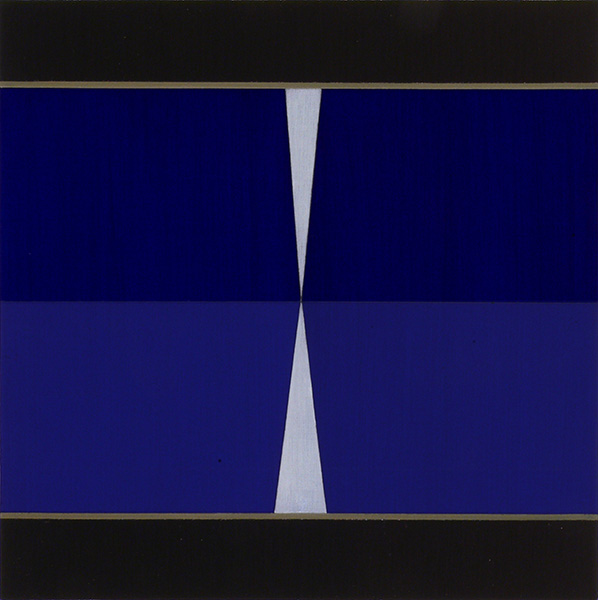
October 29, 2018
Don Voisine at Gregory Lind Gallery
By Anton Stuebner
The paintings of Don Voisine (NA 2010) exhibit a formidable, even disquieting, restraint that can appear impenetrable. Dominated by hard-edged shapes rendered in cool hues, his compositions reject pictorial representation while displaying a commitment to minimalist aesthetics. Closer inspection, however, reveals cracks in the surface: small ruptures in the wood panel, for example, or pearls of slightly too-thick, unsmoothed paint. In these small but impactful moments of visual disruption, Voisine’s work reveals that the formal purity vaunted by abstraction’s proponents is illusory, while reminding viewers of the inexorable reality, as poet W. B. Yeats presciently remarked, that “things fall apart; the center cannot hold.”[i]
Blues and the Abstract Truth, Voisine’s solo exhibition at Gregory Lind Gallery, draws most directly from the language of visual abstraction, and the paintings on view display a precise control of form and color as expressive mediums. Voisine’s titles, however, suggest specific relationships to people (Svetlana, Stephan) and places (Lake Drive, Red Sea Crossing), a gesture that invites questions about how representation becomes destabilized when pictorial or figurative signifiers are gone.
Voisine’s own mark-making—and its traces—functions as the most apparent signifiers of presence in the works on view. His juxtaposition of matte and high-gloss paint, in particular, draws attention to how materials can either hide or reveal the artist’s hand. In Lake Drive (2018), for example, Voisine renders the same shape (a right trapezoid) in two different shades and finishes of blue paint, an effect that posits a formal structure of inversion or mirroring within the composition. The contrasting paints, however, also evoke a startling tension between presence and absence, the high-gloss paint revealing the same cross-hatch brush strokes that the super-flat finish all but obscures.
In other works, the high-sheen finish evokes a mirrored surface that brings viewers “into” the painting while implicating them in these same tensions between embodiment and erasure. The glossy, distorted black square in Citadel (2018), for example, reflects a viewer’s image back to her—but only in silhouette, the mirror image becoming a ghost-like apparition without discernible or identifying features. Through this double effect of reflection and negation, Citadel evokes associations of how individuals are subsumed in the face of larger bodies of power (such as the “citadel” of its title), while also suggesting the instabilities—as well as slippages—between figuration and abstraction.
[i] Yeats, W. B. “The Second Coming.” Poets.org. July 23, 2015. Accessed October 1, 2018. https://www.poets.org/poetsorg/poem/second-coming. Poem originally published in 1919.


